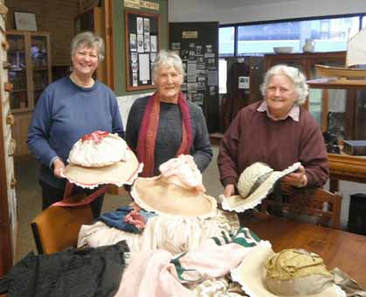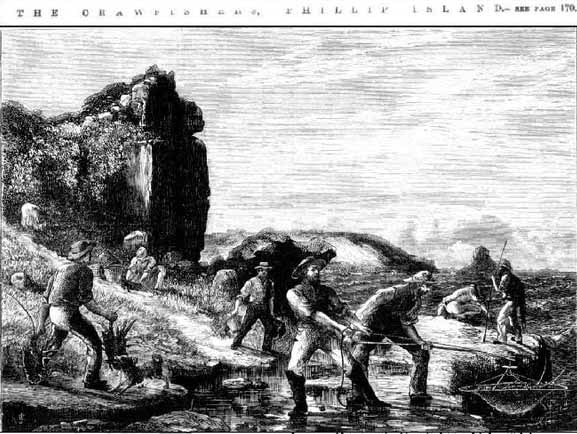 Historical Society members Christine Grayden, left, Anne Davie and Jan Andrews look through costumes and bonnets on loan from the Wonthaggi Theatrical Group for the re-enactment of the first land ballot for closer settlement on Phillip Island.
Historical Society members Christine Grayden, left, Anne Davie and Jan Andrews look through costumes and bonnets on loan from the Wonthaggi Theatrical Group for the re-enactment of the first land ballot for closer settlement on Phillip Island. Descendants of some of Phillip Island’s first selectors will be among a cast re-enacting the first land ballot in Cowes next weekend.
| By Catherine Watson IT WAS the opportunity of a lifetime when hopeful selectors gathered 150 years ago for a chance to own their own piece of paradise on Phillip Island. On November 2, 1868 Victoria’s Land Commissioner conducted the first land ballot for closer settlement on Phillip Island in the court house at Schnapper Point (later Mornington). Surprisingly, for what was on offer, only 132 prospective settlers entered the draw for the 157 allotments. They were allocated parcels of land ranging from one to 160 acres. Afterwards The Australasian was moved to comment: Although it is to be regretted, for more reasons than one, that the island is not to be retained as national property, there is this much to be said – nearly the whole of the land selected on Monday has undoubtedly fallen into the hands of persons who intend to settle upon and cultivate it. Nearly the whole of the applicants were farmers, farm labourers and hard-working men, or persons desirous of obtaining perhaps one of the best sites within the whole colony for a seaside residence. In the Cowes Cultural Centre next weekend, descendants of some of those first selectors will be among the cast of a re-enactment of the first land ballot. The performance will be narrated by Bass Coast Mayor Pamela Rothfield, a descendent of a ballot selector Cleeland and slightly later settlers McFees. Mike Cleeland will play the Land Commissioner. Andrew Box, a descendent of ballot selector Richardson, will be the Assistant Land Commissioner, and well-known Offshore Theatre actor Ashley Reed will play the role of an Argus journalist. A sub-committee of the Phillip Island & District Historical Society has been working for many months on the re-enactment, the culmination of a year of events marking the first 150 years of European settlement on the island. Most of the selectors are farmers. There are some miners, some fishermen, some tradesmen and some labourers. A few give their occupation as “gentleman”, perhaps searching for the “best sites within the whole colony for a seaside residence”. The Australasian’s report mentions “two ladies” in the ballot. No women’s names appear in the list of successful selectors, although a few of the names are initials. John Jansson, from the historical society, has been researching the selections, but says he has ha no luck in tracing the two women. “Catherine Miller was mentioned but she lodged her application for a licence for lot 6 in April 1871. We have a copy of her application. “Jane Watt was also mentioned but her husband James Michie Watt was the applicant in the February 1869 ballot. James died in 1872 and the family settled on lot 20 on Watts Road after his death. They stayed for about six years then left for Port Melbourne. “There may have been two women but until more documents turn up we will never know.” John has been trying to work out what lots each selector got in the first ballot but he says there is so much missing information it is impossible. “Most of the selectors gave up in the first year or two and never got titles to their lots.” The Australasian ends its report with news of further development on the island. “In a short time it is rumoured that the rest of the island, with the exception of some reserves, will be sold by auction, and that the township allotments near the mussel rocks [Cowes] will also be disposed of in the same manner.” The historical re-enactment will be held in the Cowes Cultural Centre on Saturday, November 10. Entertainment will start at 2pm with guitar and mandolin players playing traditional Australian folk tunes with the performance at 2.30pm. The audience is invited to dress in period costume for the re-enactment and join in the spirit of the afternoon. Afternoon tea will follow the performance. | THE SELECTORS (IN ORDER OF BALLOT DRAW) Thomas Mitchell Fellstead, farmer James McIlwraith, farmer Thomas Wilson, farmer; George Thorn, road contractor Wm McKay. farmer James Chambers, ironmonger Frederic Poole, farmer Joseph Cleeland, farmer John West, market-gardener Robert Byrne, jnr, objected to and disallowed, only seventeen years of age Robert Fletcher, wood carter Charles Newport, butcher John Cheque, farmer David Reed, sailor E.C. Amsinck, gentleman W. M. Mackenzie, store keeper John Houston, gentleman George Beard, farmer Thomas Kanine, farmer Daniel Adams, commercial traveller Anthony Scott, farm labourer R. C. Miller, spirit merchant George C. Scott accountant Geo. Cox. Fisherman Joseph Richardson, farmer William Pearson, hotelkeeper W. S. F. Murray, auctioneer (not allowed, said he owned 1,400 acres already) Chas. Craydon, fisherman Fred. Peatling, maltster William Cochrane, gardener Richard. Craydon, fisherman Thomas Rennison, hotel keeper Edward Phillips, carpenter John Barrett, storekeeper C. E. Verdon, cattle dealer James Wilson, farmer Edley North, contractor William Barter Oat, hotel keeper William S. Potts, clerk Frederic Hollier, market gardener Richard Bowman, saddler John Rogers, farmer George Morgan, carter Joseph Taafe, miner James H. M'Gregor, gardener Michael Fox, farm labourer John Whitney, ironmonger William Turnbull George Pool Benjamin Bagster, storekeeper David Burton, sheep farmer Alfred Jones, farmer Murdoch Macdonald, farmer James Scott, teacher John Love, farmer Charles Chapman, farmer P. Hugo McHugh, surveyor Francis Cleeland, farmer Malcolm McDonald, farmer William Love, farmer Jas. D. Anderson, mining agent Samuel F. Bury, quartz miner John M. Watson, ironmonger Alexander Ross, farmer Robert Byrne, auctioneer Horatio Beauchamp, auctioneer Samuel Hall John Sharples, schoolmaster B. Arundell Hill, farm labourer Francis Stephens, solicitor Thomas Smith, bootmaker W. A. Hunt, farmer Michael Jas O'Connor, grazing farmer Robert Dunn, maltster Alexander Watt Bowman, grazier William Woolley, surveyor Thomas Warr, farmer Wm Smith, bootmaker Jas. Chas. Hann Wm. White Michael Molony, farm labourer Wm. Power, gentleman Jamas Broadrick, labourer Wm. Henry Hobson. boardinghouse-keeper David Mains, farmer Samuel Mann, hotel keeper Chas. Young Skinner, fisherman Jonas Watson, storekeeper John L. L. Campbell, miner Preston Parsons, butcher John B. Lock, farmer James Murray, carpenter William Hutchinson, bootmaker E. J. B. Nunn, solicitor Alfred Cooper, auctioneer John Lett, maltster Henry J. Smith, gentleman H. S. Skinner, fisherman Frederic Williams, salesman H. J. M. Skinner, fisherman F. A. Jellett, gentleman Matthew Lang, spirit merchant Angus Love, farmer John Maclennan, miner. Source: The Australasian, Nov 7, 1868 |

Not quite three years after the ballot for land, on September 9 1871, the Illustrated Australian News published a front-page engraving of some of the island’s fishermen pulling in crayfish. According to the article, about 400 people – “a hardy race” – lived on Phillip Island, clearing the land and fishing for a living. A full-size copy of the engraving is on display at the Phillip Island Historical Society Museum.